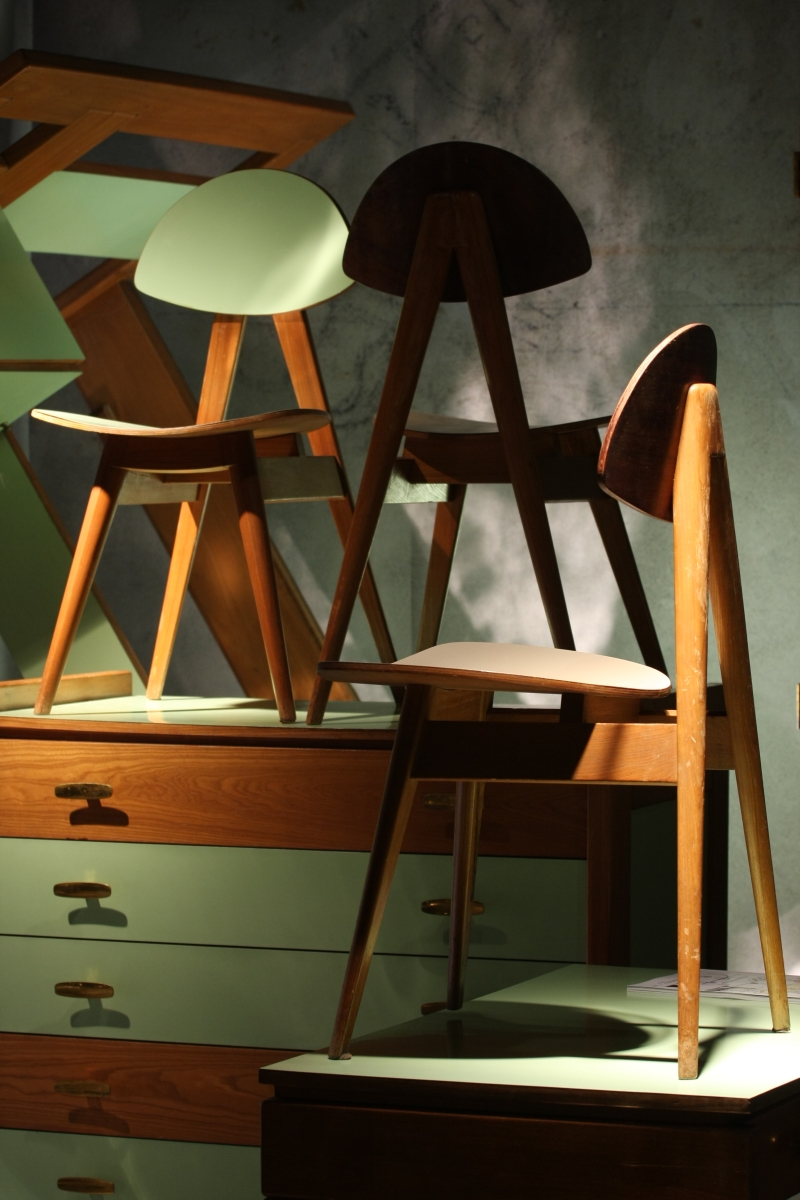While the art world is awash with anecdotes of cleaners disposing of installations having confused them for rubbish, we're not aware of any works of designer furniture having suffered a similar fate.
At Design Miami Basel 2014 however Milan based Erastudio Apartment-Gallery made a very good effort to initiate just such a première with their presentation of a 1950s bedroom ensemble by Ettore Sottsass: piled ungraciously, almost out of hand, in the corner of their stand the bed, chest of drawers, table, wardrobe and chairs looked for all the world like they were waiting for the bin men to come and cart them off to the dump.
Something that would have been a greater cultural loss than the binning of any art work.
Created in context of a competition by the Italian design/architecture magazine Domus and the company Formica - producers of, Formica - the Sottsass collection was without question one of our highlights at Design Miami Basel 2014. Or at least the chair was. A chair that although officially designed for the bedroom just screams "kitchen" at you with its gorgeous milking stool aesthetic, beautifully thought through rustic elegance and which with its adorable simplicity positively shines in contrast to much of Sottsass' later furniture design work with its more intellectual, philosophical origins. And is surely, but surely, a piece worthy of a re-edition.
Just delightful.

Featuring 50 global design galleries Design Miami Basel 2014 was the expected mix of decadence and grace. Or was almost the expected mix. For although the 2014 edition had everything you would expect, nay want, from such a fair, for us it lacked a little of the geniality, the sparkle, of past editions, everything being somehow more matt, less attention grabbing. You just didn't get the feeling that the galleries were pulling out all the stops. Something which is probably a sign that the market is buoyant and the galleries need make only minimal effort to attract buyers.
For us however a visit to Design Miami Basel is all about enjoying the works on display and making new discoveries from design's rich tradition.
Something we achieved with the expected ease.
Following on from the refined elegance of last year's "Maison des Jours Meilleurs" by Jean Prouvé, Paris based Galerie Patrick Seguin went "back to nature" this year with a delightfully hillbilly-esque wooden house by Jean Prouvé and Pierre Jeanneret. The so called F 8x8 BCC from 1942 was created as part of the pairs efforts to produce simple, yet comfortable, temporary accommodation for war refugees, and the use of wood arising from a shortage of other materials. A forced decision it may have been, but one which gives the house a sylvan charm that belies its modernist origins. A genuinely intriguing and stimulating work.
Aside from the F 8x8 BCC there was generally an awful lot of of Jean Prouvé on show at Design Miami Basel 2014. An awful lot.
An awful lot of Jean Prouvé and an awful lot of Gerrit T. Rietveld. Both are generally always very well represented in Basel, but this year we had the feeling that more galleries than most had them as a focus.
Similarly, in his centenary year Hans J. Wegner was, thankfully if predictably, also a recurring theme at Design Miami Basel 2014, perhaps most impressively at Dansk Møbelkunst Gallery with, amongst other pieces, a Wishbone Desk and the truly charming 1956 Fruit Bowl while Galerie Eric Phillipe complimented a 1959 Yoke Armchair and a 1954 two drawer desk with a delightful brass and mahogany table lamp by Finnish designer Paavo Tynell.
Away from the design classics, the contemporary galleries and designers left us a little cold this year, too much of it formulaic and simply looking like objects created to meet buyers and journalists expectations; a situation perhaps best represented by Konstantin Grcic's pavilion for Audi. A truly ridiculous piece of corporate sponsored nonsense. And while the specially commissioned installation Triangular Series by Jamie Zigelbaum may have been visually impressive, we genuinely struggled to fully comprehend its justification as contemporary design. It wasn't uninteresting, but also didn't do anything interesting in an interesting way or for an interesting reason. A phrase applicable to much of the contemporary work on show.
Consequently we were left with a fair where the contemporary highlights were older works including mischer'traxler's 2011 "It takes more than one" mirror at Victor Hunt Designart Dealer and Max Lamb's Pewter Stools at Johnson Trading Gallery, while with his Man Machine collection for Galerie Kreo Paris Konstantin Grcic perfectly demonstrated what a genial talent he is. And so made good the ground lost with the other aforementioned, ridiculous, project.
As ever we don't really understand Design Miami Basel, principally because the main buyers are either museums and similar institutions or specialists who know what they want and where they can purchase it. And so we don't really "get" the need to stage such a public event. But then we famously don't understand book fairs either. Fortuitously one doesn't have to understand Design Miami Basel to enjoy it and learn from it.
And equally fortuitously the Design Miami Basel cleaning team understand high quality 20th century furniture design.
A few impressions from Design Miami Basel 2014